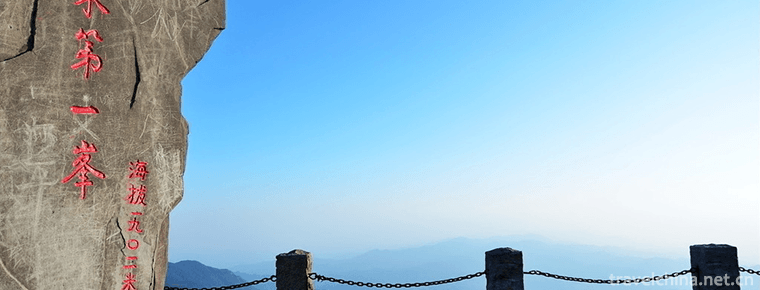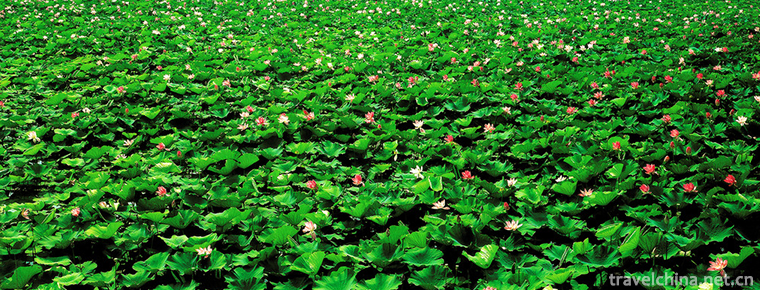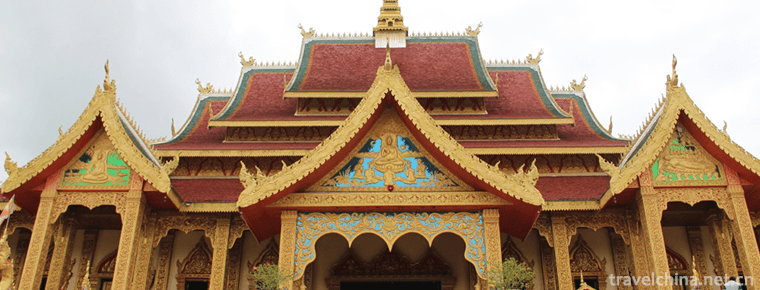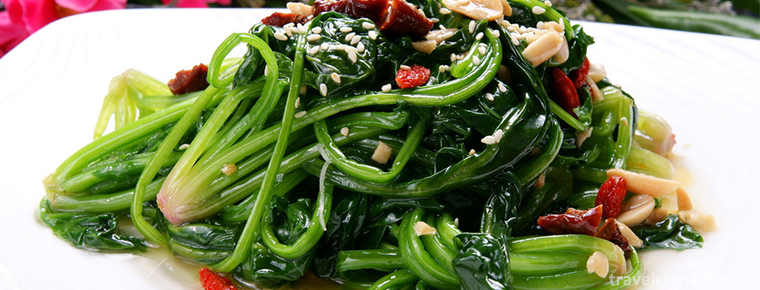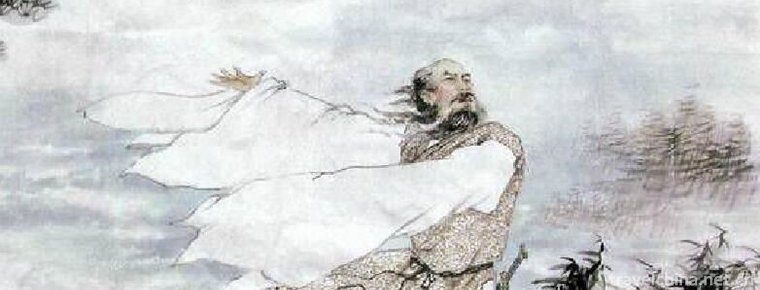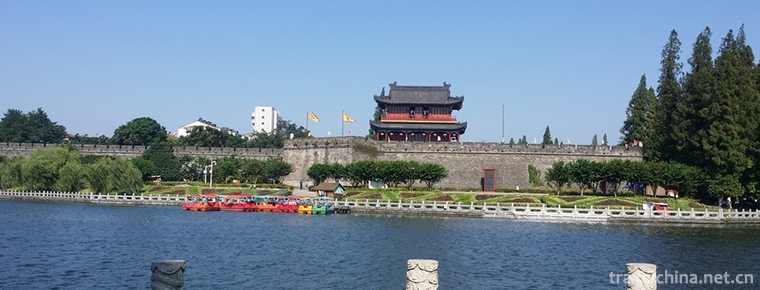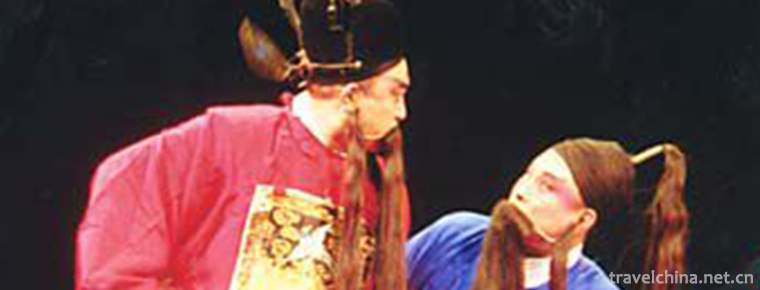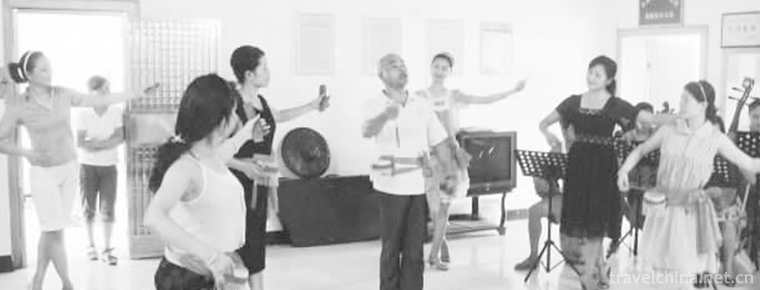Taoping Qiang Village
Taoping Qiang Village
Taoping Qiang village is located in Taoping Township, beside Zagunao River in Lixian County. Qiang village is 40 km away from Lixian City, 16 km from Wenchuan city and 139 km from Chengdu. It is a national key cultural relics protection unit and an important scenic spot in Jiuhuang line tourism circle.
Taoping Qiang village is one of the most complete preserved watchtowers and residential buildings in the world, enjoying the reputation of "natural air conditioning". The labyrinth architectural art of its perfect underground water network, passageways extending in all directions and watchtowers is praised as "living fossil of Qiang architectural art" and "mysterious oriental ancient castle" by Chinese and foreign scholars.
Traffic information
There are more than ten shuttle buses to Wenchuan County at chadianzi passenger station in Chengdu every day. There are minibuses or minibuses from Wenchuan county to Taoping. The ticket price is about 10 yuan.
geographical environment
Taoping Qiang village is 40 kilometers east of Lixian County and 180 kilometers away from Chengdu City. The village is a typical representative of the Qiang architectural community. A yellowish brown stone house is built along the steep mountain slope. There are many blockhouses in the village. It is known as the most mysterious "Oriental Castle".
Taoping Qiang village has eight radial exits centered on the ancient castle. The exits connect with the corridor to form a road network. The people of this village can advance and retreat freely, and outsiders can enter the maze. The village houses are connected with each other, and the outer walls are constructed by mixing pebbles and rubble. The lanes in the village are vertical and horizontal. Some of the houses are built with low walls, which keeps the habit of "dome house" of ancient Qiang people. There are two to three floors of houses with wide rooms and vertical and horizontal beams and columns. The upper part is used as a house, and the lower part is equipped with cattle and sheep pens or farm tools. A "small tower" is often built on the roof of the house to worship the white stone God of Qiang people (a white oval stone). The underground water supply system in the castle is also unique. The spring water from the high mountains flows to each household through the underground ditch. It can not only adjust the indoor temperature and be used as fire-fighting facilities, but also avoid the enemy's water cut-off and escape in case of war.
History and culture
Taoping has a long history. According to historical records, the village was built in 111 B.C. and guangrou county was set up here in the Western Han Dynasty. Taoping, as a pass under the jurisdiction of the county, has existed for more than 2000 years.
Taoping Qiang Village
Taoping Qiang Village
Taoping Qiang Village
Taoping Qiang Village
Taoping Qiang Village
Taoping Qiang Village
Taoping Qiang village, Qiang language "Qizi", is close to the mountains and rivers, rich in soil and water, outstanding people. Zagunao River, a tributary of Minjiang River, passes through the village. The village is a collection of simple and strong folk customs, magic and unique Qiang architecture, natural Qiang thorn show and unrestrained Qiang song and dance, showing the simple and confusing history of Qiang people. When night falls, the bonfires are blazing, and the Qiang family members are singing and dancing around. It is often "the Qiang people are dancing and singing all night, and they don't know that the red sun is already in the pupils."
"The Dragon came to Diqiang at the head of the Yellow River and had a long journey in autumn." Up to now, the oldest and more mature character found in China is the oracle bone inscriptions, the representative characters of the Yin and Shang Dynasties more than 3000 years ago. In oracle bone inscriptions, there is one and the only one about the title of nationality (or clan or tribe), namely "Qiang", which is the earliest record of Chinese human race name. "Shuo Wen Yang bu" says, "Qiang, Xirong shepherd also, from people from sheep, sheep also sound." Qiang belongs to his name, that is, the general name of the nomadic people in the West (Shaanxi, Gansu, Ningxia, Xinjiang, Qinghai, Tibet, Sichuan) by the Central Plains tribes at that time. Therefore, we can say for sure that the Diqiang ethnic group is by no means a single ethnic group. They have different languages, costumes and customs. The only thing in common may be the nomadic lifestyle of "living by water and grass".
The end of Yangshao culture
At the end of Yangshao culture (about 3000 B.C.), there were two tribes in the middle reaches of the Yellow River. The differentiation of the surname Jiang of Yan Emperor, Jiang and Qiang is the different expression of matriarchal society and patriarchal society. Oracle bone inscriptions often use each other. Both Jiang and Qiang are like people wearing sheep horn headdress, representing primitive nomadic tribes originated in Northwest China with sheep as their totem. "Jin language · Guoyu": "in the past, Shaodian married the Chong family and gave birth to Huang Di and Yan Di. The Yellow Emperor was made of Ji Shui, and Yan Emperor was made of ginger water. Success is different from virtue, so the Yellow Emperor is the concubine, and the Yan Emperor is Jiang. " Yandi belongs to the ancient Qiang tribe with many tribes.
In the later wars, most of the Yandi tribes and the Huangdi tribes merged with each other and became the Huaxia nationality (the ancestors of today's Han nationality). The other part went westward or southward to merge with the local aborigines, and became the ancestors of other ethnic groups other than Han and Qiang, such as Tibetan, Yi, Naxi, Bai, Hani, Susu, Pumi, Jingpo, Lahu, Jinuo, etc.
Ancient times
Around 2100 B.C., Dayu, a Qiang nationality who was good at flood control, succeeded to the general leader of the tribal alliance. Yu bid farewell to the mountains of his hometown for the safety of the people in the world, and began a long way to control the flood. He devoted himself to the flood control and dredged the Jiuhe river. He made remarkable achievements in the war. Among the people, there was also a story about the great Yu king who "passed through his family three times but did not enter"!
King Dayu later broke the "abdication system" and was said to be located in his son Qi, known as "Xia Qi" in history. After he ascended the throne, Qi united with other tribes to establish the first formal state in Chinese history in Yangcheng (now Gaocheng Town, Dengfeng County, Henan Province), which lasted for more than 500 years.
Qin Dynasty
In 221 BC, Ying Zheng, the king of Qin, attacked and destroyed Qi, Chu, Yan, Han, Zhao and Wei States, unified China, established the first centralized feudal state in Chinese history, and started a feudal society lasting more than 2000 years. Qin Shihuang was born in Tianshui, Gansu Province, where the Qiang people lived. There is still a saying that the ancestor of Qin Shihuang began in songpinggou, Maoxian County, where Qiang people live today. The clan of Qin was determined by Professor Meng Wentong as "a military of Qin, and there is no doubt about it.". After the founding of the people's Republic of China, he moved eastward to Xianyang, Shaanxi Province, and issued laws and regulations forbidding the use of troops against the Qiang Rong tribes in the West.
Han Dynasty
In the Han Dynasty, the Qiang people in Sichuan established yak and Qingyi Qiang States, which governed the areas of Xichang, Ganzi, Ya'an and Leshan, with the capital in Lingguan town of Baoxing county. In the Western Han Dynasty, the population of Qiang Nationality in Hanyang (Tianshui), Jincheng (Lanzhou), anbeidi and Longxi counties reached 259990 households and 1001802 people. In the Western Han Dynasty, the Qiang people lived in Shandong, Hebei, Henan, Inner Mongolia, Shanxi, Shaanxi, Gansu, Ningxia, Xinjiang, Qinghai, Tibet, Sichuan, Yunnan, Guizhou and other provinces. The population of Qiang people reached more than 12 million, accounting for 1 / 4 of the national population (at that time, the national population was 59.95 million). In the period of the Sixteen States in the Eastern Jin Dynasty, the Diqiang people in Northwest China established Chenghan, qianqin, Xiaxia, Houliang, houzhao and other countries. However, they were all transitory and had no strong vitality and influence.
the tang dynasty
In 881 ad (the end of the Tang Dynasty), Tuoba Sigong, a Qiang Nationality in Dangxiang, established the Daxia regime in xiazhou (now baichengzi, the border between Inner Mongolia and Shaanxi), and governed Xia, Sui, yin and Yu. Xia state is a country with Dangxiang Qiang people in Shaanxi, Gansu, Ningxia and Qinghai as the main body, including other ethnic groups in Northwest China. There are eight ethnic groups in Dangxiang Qiang, including Xifeng, FeiTing, Zhili, pochao, Yeli, MICAO and Tuoba. The Tuoba family is the strongest and plays a leading role in the group. Later, due to the continuous invasion and harassment of Tubo, he applied to the Tang Dynasty government to move to Shaanxi and Ningxia.
In 1031, the 11th emperor, lideming, died, and his son, liyuanhao, was named xiajingzong. In 1032 A.D., Yuanhao changed his name to Wei, claiming himself "Wu Zhi" (qingtianzi), and established the national name as "Daxia" (because in the west of Song Dynasty, Song Dynasty called "Western Xia"), the year of which was the first year of Xia Jingzong. The Western Xia territory includes the present Gansu Province, Ningxia all, Northern Shaanxi, Qinghai, Inner Mongolia, a total of 32 states, the state is in Xingqing mansion (Yinchuan City). In 1226, the Mongol timuzhen (Genghis Khan) sent soldiers to the summer. The next year, the Mongolian army took it hard, breaking the city of the great Xia state, and the people were killed and killed badly. Genghis Khan was also seriously injured in the war. In order to avoid the greater casualties and losses of the people, the emperor saw the decline at the end of the 21st century. The Mongols respected the lives of Tiemuzhen, killed Xia Jian and destroyed the King Mausoleum of the great Xia. So far, the state of Daxia died in 346 in 1227, and its descendants still distributed in Taoping Township, Li County, Aba Prefecture and Danba, Ganzi Prefecture.
Areas under its jurisdiction
Sichuan was Bashu state in ancient times and Liangzhou in Xia Dynasty. Bashu comes from Diqiang, and cancong (the former residence of Canling, located in Diexi Town, Maoxian County, Aba Tibetan and Qiang Autonomous Prefecture, Sichuan Province, was destroyed in the Diexi earthquake on August 25, 1933). Li Bai in "Shu Road difficult" chanted: "cancong and Yufu, how the founding of the country is at a loss." In the same area, the ancient Qiang people also built range (pronunciation similar to "rmmea", which is the former residence of 300000 Qiang people today. Its jurisdiction includes Maoxian, Wenchuan, Lixian, Heishui, Songpan, Jiuzhaigou, malkang, Jinchuan, Xiaojin, rantang, ABA, Hongyuan, Ruoergai, etc County. During the Three Kingdoms period (221 AD), the territory still included Dujiangyan (formerly known as Du'an County, Qiji County, Guanxian county), Pengxian county (Baima County, xingle County in ancient times), Beichuan (Qiang Autonomous) county (Shiquan County in ancient times), Qingchuan county (Guangwu County in ancient times), Pingwu County (Gangdi County in ancient times) and Wenxian County of Gansu Province (formerly called Yinping county). The capital of Qiang in Han Dynasty was located in Fengyi Town, Maoxian county.
branch
In addition, the ancient Qiang includes Jiang's Rong, Xianling Qiang, shaodang Qiang, Zhong Qiang (Zhongcun Qiang), Le'er Qiang, Bei'an Qiang, Dangjian Qiang, Han Qiang, qifrozen Qiang, Qianren Qiang, Laojie Qiang, Fengyang Qiang, Xiangjie Qiang, Shaohe Qiang, Gongtang Qiang, quanwuzhong Qiang, Heishui Qiang, Beihe Qiang, weiwai Qiang, Baosai Qiang, Hequ Qiang, FA Qiang, Yao Qiang, Xiye, Puli, Agou Qiang, and yak Niuqiang, shenwolf Qiang, Qingyi Qiang, Baima Qiang, Baima Qiang, brandqiang, Keran Qiang, Dangchang Qiang, dengzhiqiang, dengzhiqiang, Wenshan Qiang, dangqiang, baigouqiang, golongqiang, ganglin Qiang, Nanshan Qiang, qianzu Qiang, Qianshui Qiang, Qianshui Qiang, Qianqiang, Qianqiang, baoba Qiang, Baicao Qiang, Heihu Qiang, luodagu Qiang, Yang Qiang, Caopo Qiang, qingpianqiang, Qianqiang, Qianshan, Wenshan, Wenshan, dangqiang, Dangchang, TangChang, dengzhiqiang, Wenshan, Wenshan, dangqiang, dangqiang, Qianqiang, Nanshui, Nanshui, zuqiang, Qiangqiang, Qianqiang, baobaqiang, Baicao, Qianqiang, Qianqiang, Qianqiang, Qiantu, Qiantu, Qiantu, Qiantu, Qianqiang, Qiantu, Qiantu,, Lin There are more than 100 kinds of Qiang branches, including taiqiang, Xiangren Qiang, geyan Qiang, Weizhou Qiang, Canling Qiang (Xiwei Qiang), Maozhou Qiang, Wangzu Qiang, na'e Qiang, qiandiao Qiang, etc
Main attractions
local customs and practices
Taoping Qiang village seems to condense the thousand year history of Qiang people. In Taoping Qiang village, for many years, Qiang people have kept their traditional living habits. From children picking apples in the fields to old people wearing neat national clothes in front of their doors, from women weaving Qiang embroidery to young men drinking highland barley wine, they all present a kind of pastoral life.
The most ceremonious national festivals of the Qiang people are the "mountain Festival" (also known as the "mountain Festival") and the "Qiang annual meeting" (also known as the Qiang calendar year), which are held in spring and autumn respectively. In fact, it is a kind of agricultural activity of spring prayer and autumn reward, but it is always full of strong religious color and reflects the glory of ancient mysterious culture.
Architectural features
The huge watchtowers in the village are vigorous and upright, standing shoulder to shoulder in the village. They are high and low, from several meters to tens of meters. The building forms are four, six and eight corners. They are made of soil, stone, hemp tendon and wood, and some are only civil engineering. Zhaizi is a complex of stone blockhouses and residential buildings. It is made of rubble and yellow mud, and is still intact after numerous earthquakes. The tunnel between the wall and the wall is deep and mysterious. Because of the houses built on some roadways, there are countless dark paths. Walking into them is like stepping into the labyrinth of history.
During construction, no drawing, no measurement, no hanging line, no hand laid, the structure is symmetrical, the edges and corners are abrupt, majestic and firm, and exquisite and chic. It is an unparalleled spectacle in the history of architecture in the world. It is amazing and attracts a continuous stream of tourists from home and abroad to visit and inspect.
Contrary to the traditional architectural form of the ancient city, Taoping Qiang village has eight radial entrances and exits centered on high Diao. The eight entrances and exits form a road network extending in all directions with 13 corridors. The villagers can get in and out freely, while the outsiders are like entering the maze of eight formations. They can't pass without the guidance of the villagers. Underground in the village, a large number of underground water diversion channels have been excavated, covered with stone slabs and soil. A certain distance, there are movable stone slabs, which can be opened to get water. These canals are convenient and confidential. They are woven into a water network flowing through each watchtower in the village, providing huge living space for wartime. Taoping's magical road network, water network and roof make up three kinds of three-dimensional road network and defense system in the interior of Qiang village, i.e., upper, underground and air. This is also the unique feature of Taoping Qiang village.
A group of buildings that combine tall stone blockhouses with residential buildings. The oldest building in this village was built two thousand years ago with yellow mud and flake stone. It integrates mathematics, geometry and mechanics, showing the glory of the ancient Qiang Nationality in history.
Diaolou is the landmark building of the whole village. There are only two left. One is the residence of Chen Shiming's family, and the other is located on the river bank opposite the village. The watchtower is divided into nine floors, about 30 meters high. There are shooting windows on each floor. The bell hole on the top floor is used for transmitting messages.
For Qiang architecture, materials are drawn from the nearby mountains, and the soil, stone and other resources on the nearby mountains are used. First, a square trench with a depth of 1-2 meters is dug on the selected ground, and large pieces of stone are used to build the foundation. It is about three feet wide, and then mixed yellow mud is used as slurry to glue rubble. The stone wall gradually becomes thin from bottom to top, and gradually shrinks. The center of gravity of the stone wall is slightly inclined to the interior, forming a centripetal force, which can be firm and stable by squeezing each other. From bottom to top, the roof structure is composed of main beam, shell, split layer, bamboo pole and yellow thorn. Brown rake, with national characteristics.
Taoping Qiang village is called "Oriental mysterious castle" for its typical Qiang architecture and complex road structure. It is the most complete "living fossil" of Qiang architecture culture and art in the world.
Cultural relics
"Stone coffin burial" is found in Jiashan village. Most of the burial objects are pottery, and there are also copper, iron and wooden objects. It shows the ancient history, unique customs and national culture of Qiang nationality to the world, and provides rich folk investigation and research basis for people. The Qiang nationality dances Shalang (meaning singing and shaking), drinks Za wine, plays Qiang flute and embroiders. Taoping Qiang village is built on the mountain, and Zagunao River runs past the village. In the village, there are two earthen house carvings built with nine layers of stone, facing the beacon tower on the other side of the mountain. The houses in the Qiang village are built on the slope along the mountain. They are all built with stones. The ancient Qiang ancestors built a ditch to lead the mountain spring under the houses in the village. It is very convenient for drinking and fire fighting to get water. People can walk in the village but hear the sound of water Ding Dong on the ground. Taoping Qiang case is called "living fossil of architectural culture and art" by Chinese and foreign experts. Most of his residence is "living in the mountains, and the tired stone is the room". Taoping Qiang village is the most typical Qiang architecture. Stone, soil and wood, in the hands of the industrious Qiang people, miraculously built a Qiang village more than ten Zhang high. They have lived on this land for generations, living and reproducing, sowing ideals and harvesting hope. When you enter the Taoping Qiang village, you will enter the ethnic group. You can enjoy the rich Qiang customs, feel the ancient history of the Qiang nationality, appreciate the mysterious culture of the Qiang nationality, and taste the unique flavor food. You can't help but be moved by the spirit of self-improvement of this nation, and also can't help being convinced by the idea that this nation is going to be brilliant.
Gubao Qiang flute
Qiang flute is an ancient single reed air sounding instrument in China, which has a history of more than 2000 years. It is popular in Aba Tibetan Autonomous Prefecture in northern Sichuan Province. The two pipes with several holes (formerly five holes, now mostly six holes) are made of oil bamboo growing on the local mountain. The bamboo joint is long and the pipe body is thin. The two pipes are side by side and connected with wires. The total length of the pipe is 13-19 cm. The diameter of the pipe mouth is about 2 cm. The upper end of the pipe is equipped with a 4 cm long bamboo nozzle. The front of the blowing mouth should be flattened with a knife, and at the upper end of about 3cm, a thin piece of reed should be cut with a knife. It is mainly used for solo. There are more than ten ancient tunes. The content of the music is quite extensive. It mainly conveys the yearning and yearning of the Qiang people. The Qiang flute is played vertically. The two pipes give out the same pitch. The timbre is clear and high, and it has a sense of sadness. "Why should the Qiang flute blame the willows? The spring breeze does not pass through Yumen pass" is the best portrayal of its expressive force. Therefore, it is most suitable for solo performance and can also be used as accompaniment for singing and dancing.
There is a big difference between Qiang flute and flute, which are two different concepts. In the ode to flute written by Ma Rong of the Eastern Han Dynasty, "in modern times, the two flute systems have been started in the Qiang nationality. The Qiang people have not been able to cut the bamboo, and the Dragon chanting has not been seen in the water Therefore, we can know that the Qiang flute has been spread in Gansu, Sichuan and other places in the Han Dynasty, and it can be inferred that the Qiang flute at that time was a double pipe four hole Qiang flute. In the Tang Dynasty, the Qiang flute was a common instrument on the frontier fortress, which often appeared in the frontier fortress poems of the Tang Dynasty. It is worth mentioning that the Qiang flute did not appear in the "ten music" of the Tang Dynasty. It can be seen that the Qiang flute was only an instrument seen in the frontier fortress in the Tang Dynasty. It did not officially enter the court or army of the Tang Dynasty, but was a kind of self entertainment instrument used by ethnic minorities or soldiers in the army.
In the poems of Tang, song, yuan and Ming Dynasties, there are many records about Qiang flute. Now in the Qiang areas of Maowen Qiang Autonomous County and Heishui County in Sichuan Province, we can still see this kind of musical instrument with Tang and Song Dynasty heritage. They are made of two oil bamboos of the same length. The tubes are cut into square columns and bound together. At the upper end of each pipe, there is a blowpipe with bamboo spring, which is 17cm and 19cm in size. The timbre is high and a little sad Feeling is the main musical instrument commonly used by people during the festive harvest and labor during the Spring Festival. It is also a way for young men to express their love to girls.
The Qiang flute in CHIBUSU and Shaba areas was brought from the western region by the Qiang people who moved south during the Qin and Han war. According to historical records, before the Western Han Dynasty, there were four holes on the surface of the Qiang flute. In the first century A.D., the musician Jingfang added a high tone to the hole to form five holes. Ma Rong of the Eastern Han Dynasty has a record of "the modern double flute from Qiang" in his flute Fu. In modern times, the Qiang flute has become six holes. Therefore, the existence of Qiang flute has been at least 2000 years old.
The modern Qiang flute is made of local oil bamboo (long slub and thin tube). Two bamboo tubes with the same diameter and length are selected, and the bamboo skin is cut off to form a square column shape (some flatten the adjacent outer skin of the two pipes), and bind them with thin lines at the head, middle and tail. The tube body has no joints, with a total length of 13-19 cm, with five or six holes (the same distance between holes). Bamboo reed whistle is installed on the upper end of the pipe (the front side is flattened and the reed tongue is upward)
When playing, he has a double reed in his mouth and presses the hole with his food, middle and ring fingers. The range is C1-C2. The timbre is crisp and bright, with a sense of sadness. The sound of the Qiang flute often gives people a feeling of illusion, confusion and soul stirring. The Qiang people often use it to express their feelings of happiness, anger, sadness, separation and reunion. The repertoire often performed includes "Ci of folding willows", "melody of thought", "Ballad" and so on.
The state attaches great importance to the protection of intangible cultural heritage. On May 20, 2006, the performance and production techniques of Qiang flute were listed in the first batch of national intangible cultural heritage list by the State Council.
Cultural characteristics
Qiang food
It is one of the main features of Taoping Qiang village. If you are lucky enough to visit the Qiang family, the warm and hospitable host will bring you the fragrant and unadorned Qiangjia pork, pork leg and Liugou meat, as well as mountain wild vegetables such as mountain dragon beard, fern and cilongbao. Qiang girls will offer you a mellow highland barley wine. Under the influence of sweet Qiang's toast songs, maybe you will be drunk and hazy, or you will be floating like an immortal, which will make you unforgettable forever.
Qiang embroidery
It is a treasure in the splendid culture of the Chinese nation for five thousand years. It is also a unique skill of Taoping girl. As Qiang girls like to learn embroidery since childhood, they have become skilled in traditional crafts. When they get married, the girls must try their best to embroider out some of the best wedding dresses, the best yunyun shoes and the best insoles, otherwise they will be despised by the men. Therefore, Qiang embroidery has been passed down for more than a thousand years, and it has become the research object and collection of many experts and scholars.
song and dance
It is the main feature of Taoping Qiang village. If you don't see the songs and dances of Qiang people in Taoping Qiang village, you will feel very sorry. The Qiang people are good at singing and dancing for more than 2000 years. In the long history, they accompanied their labor with singing and expressed their life with dance, and gradually formed a passionate and unrestrained artistic style. In the songs and dances of Qiang nationality, there are some expressions of working life, some of them are expressions of love, and some of them are of sacrificial activities or exorcising ghosts and gods. There are various forms of Qiang Folk Songs and dances, including solo singing, duet singing and collective singing, such as gaipan song, Huaer Naji, etc. The Qiang Shalang dance, which is similar to the Tibetan Guozhuang but more flexible and beautiful, is the most active and unrestrained art form, which can be participated by men, women, old and young. Dozens of people, hundreds of people singing and dancing, the atmosphere is very warm. PI drum dance was originally performed by Qiang witches to worship gods. Later, it gradually evolved into a rough style Qiang dance and became a gorgeous Qiba in the Qiang dance. Every new year's festival or a wedding ceremony is held in the village, the whole village will get together, light a big bonfire, drink mellow wine, sing folk songs, dance Guozhuang, and sometimes make it all night long. When you travel in Taoping Qiang village, you can enjoy the Qiang Folk Songs and dances. You can also take part in a bonfire party. After eating roast mutton and drinking highland barley wine, you can dance with the Qiang girls in the background of the booming bonfire, so as to appreciate the profound connotation of ancient Qiang culture.
Qiang multi voice part
Intangible cultural heritage -- Qiang multi voice Department
Years and months are like songs. For many years, among the beautiful and quiet ABA mountains, there has been a kind of ups and downs, sonorous and graceful voice. In this uncut, unmodified song, people hear the sound of the years flowing, suddenly feel the time flies, can not help but wake up the memory of ancient times.
"It's beauty to have to turn (high) or low (low). One can't sing it.". In Heishui, Songpan, Maoxian border area, people understand music in this way.
5-year-old children learn to sing when they know that the voice must be high and low at the same time. Year after year, the high and low voice is in Chongshan, which is the Qiang multi voice part heard today.
It remembers every footprint of this nation in the long river of time. It awakens more tender memories of the past.
"Yu was born in Xiqiang" in historical records Many historical records, from Yanhuang to Xiayu, to the formation of Huaxia, are inseparable from the ancient Qiang nationality. At present, Qiang people mainly live in Maoxian, Lixian, Wenchuan, Songpan and other places.
In the long-term production and life, under the influence of diligence and optimism, the Qiang people express their love for life by singing and dancing. On traditional festivals and sacrificial activities, people gather to drink wine, sing folk songs and dance Guozhuang. At this time, Qiang men in long shirts, sheepskin coats, Headkerchief, belt and leather shoes and women in exquisite embroidered clothes and carved jewelry gather together to represent their villages and compete in the mountains to win or lose. There are also young men and women in groups in pairs, love each other.
When singing, as long as there are more than 2-10 people, that is, regardless of the venue and time limit, both men and women can sing. Singing time includes lead singing, round singing and ensemble singing. Day after day, "multi voice" singing is becoming more and more popular in the villages, which forms a very happy Qiang multi voice culture.
"Multi part" singing is mainly composed of two parts, including four parts, multiple parts and mixed singing of men and women. The tune goes from low to high (from a small second interval to a large second interval in a ladder shape), until the singer's voice can no longer be higher, suddenly there is a big arc of four, five, eight (not fixed). The singer's voice usually ranges from C or D of small character group to a or B of small character group I, sometimes reaching D or e of small character group II (false voice). The music is simple and elegant, passionate and rhythmic, which reflects the spirit of the Qiang people to work hard and forge ahead.
"Their skills and singing state have infected us.". In the 2007 CCTV youth song competition, the Qiang multi voice "Biman group" moved the hearts of Chinese audiences and professional judges with its simple and moving music and penetrating power from the most folk, and won the bronze award of the original ecology group of the competition. In the 21st century, the ancient multi voice part of Qiang nationality radiates new youth and vitality in the still beautiful villages and the center of the brightly lit stage.
tourist guide
Access traffic
Take a bus from chadianzi bus station in Chengdu. The order of arrival is Lixian Taoping miyaro. There are 4 buses to miyaro at 7:20, 8:10, 9:00, 13:00 and 14:50 every day. The fare is 41.5 yuan, and it takes 5.5 hours to arrive.
Stay and stay
Many people can stay in the village. Zhou Lizhi's family is an early guest of this village. The exterior of his house is an ancient building with modern decoration and several guest rooms. It is clean. The Shuqiang Inn rebuilt after the earthquake is also the first choice for guests. It is economical, affordable and hygienic. In addition, you can choose to live in Lixian County.
Stop by
Miyaro: located in Lixian County, Sichuan Province, it is the largest red leaf scenic spot in China, with an altitude of 2700 meters. "Miyaro" is a Tibetan language, which means "playful Bazi". It is located in Zagunao Valley, a tributary of Minjiang River. The climate here is cool and the scenery is excellent. Especially in late autumn, the red leaves come down from the bottom of the mountain from the top to the bottom.

-
Guangdong First Peak Tourist Scenic Spot
Guangdong First Peak Tourist Scenic Area is the largest oasis on the Tropic of Cancer. It has a large area of primitive forests, stable forest ecosystem, dense evergreen broad-leaved forests.
Views: 126 Time 2019-01-13 -
Red Beach Scenic Area
Red Beach Scenic Spot is a national 4A class scenic spot and an excellent scenic spot in Liaoning Province. Located in Zhaohuanhe Township, Dawa County, Panjin City, Liaoning Province.
Views: 161 Time 2019-01-16 -
Libo Karst
Maolan National Karst Forest Nature Reserve, located in the southern suburb of Libo County, is a well-preserved natural forest vegetation in the karst landform of the central .
Views: 156 Time 2019-01-29 -
Weishan Lake National Wetland Park
Weishan Lake National Wetland Park, located in the southern part of Weishan County, Jining City, Shandong Province, is less than 3 kilometers away from the urban area..
Views: 195 Time 2019-02-22 -
Xishuangbanna Mengwan Great Buddhist Temple
Situated in the suburbs of Jinghong City, the prefecture of Xishuangbanna Dai Autonomous Prefecture, Yunnan Province, the Monastery is built according to the national AAAA standard..
Views: 125 Time 2019-02-25 -
Spinach with Eight Delicacies
Babao spinach is a traditional Shandong dish, which belongs to Shandong cuisine. It is rich in color, bright, delicious, light and refreshing. In addition to spinach, Babao spinach is also equipped wi.
Views: 186 Time 2019-03-25 -
The Dragon Boat Festival
Dragon Boat Festival, also known as Dragon Boat Festival, Double Boat Festival, Midday Festival, Dragon Boat Festival, Zhengyang Festival, Bath Orchid Festival, Tianzhong Festival,.
Views: 99 Time 2019-04-28 -
Comic Opera Funny opera
Funny opera is one of the local dramas in Shanghai. It is now mainly popular in Shanghai and its surrounding Wu dialect areas..
Views: 261 Time 2019-05-04 -
Production Techniques of Mongolian Lele Car
Lele cart is a cattle cart in Mongolian area, also known as roller cart. Its origin can be traced back to the "Yuan Yuan" recorded in Han Shu. As far back as the Qin and Han Dynasties, the H.
Views: 189 Time 2019-06-03 -
Legend of the Three Kingdoms
The legend of the Three Kingdoms is a kind of folk literature which was approved by the State Council and listed in the fourth batch of national intangible cultural heritage list in 2014..
Views: 213 Time 2019-06-12 -
Yingge Liushu
Yingge Liushu, also known as Yingge Liuzi, is a traditional art form of rap and singing spread in southwestern Shandong, southern Shandong, Eastern Henan and Northern Jiangsu. Legend has it that the L.
Views: 293 Time 2019-07-14 -
Yongxin Drum
Yongxin Xiaogu is one of the traditional operas in Ji'an City, Jiangxi Province, which originated from Taoism. Legend has it that it was formed in Yongxin, Jiangxi Province during the reign of Qingdao.
Views: 177 Time 2019-07-14
